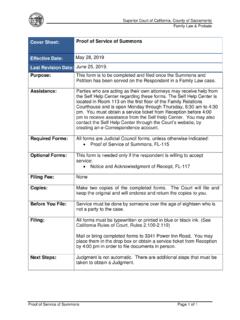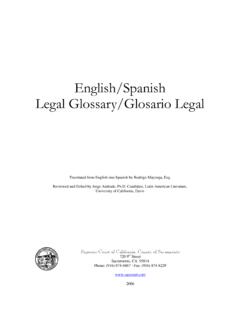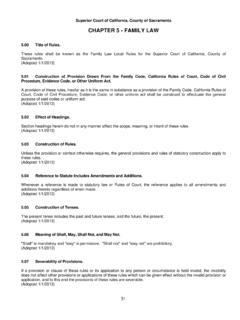Transcription of HOW TO SERVE A SUMMONS AND PETITION (STEP 2)
1 Superior Court of California, County of Sacramento Family Law Facilitator s Office Family Law Step 2 Instructions ( ) Page 1 of 4 HOW TO SERVE A SUMMONS AND PETITION (STEP 2) Purpose of the Packet This packet will provide you with instructions and forms for the completion of the next step of your case. Step 2 of the process requires you to have the Respondent served with a copy of your filed documents and blank Response forms. All of the forms you will need are available on the Court s web site. Serving Documents Now that your forms are filed, the next step is serving the Respondent. You will need the Documents to be Served on The Respondent packet for the type of case you have filed.
2 Generally, hand-delivery of the forms, which is called personal service, is required. However the Court encourages parties to cooperate in effecting service using a Notice and Acknowledgment of Receipt. Instructions on personal service and instructions on service by mail with acknowledgment are described below. Other methods of service are only allowed in special situations. If you anticipate problems getting the Respondent served by hand-delivery or if he or she lives outside of California, you may discuss your options for other service methods with a private attorney. Personal Service In order to have the Respondent personally served, follow these instructions: 1.
3 Select Another Adult to SERVE The Respondent You may not SERVE documents in your own case. Instead, select an adult friend, relative, Sheriff or professional process server to do the service of your forms on the Respondent. Both the Sheriff and a private process server charge a fee for the service. If your filing fees were waived by the court, the Sheriff may be able to SERVE your papers at no cost to you. If the Respondent is incarcerated, there should be someone at the facility who will SERVE him or her for you. You may contact the facility directly and ask to be connected to the person or department that serves legal documents on inmates. Follow carefully the instructions they give on how to obtain their help in serving the Respondent.
4 2. Provide Server with the Forms Superior Court of California, County of Sacramento Family Law Facilitator s Office Family Law Step 2 Instructions ( ) Page 2 of 4 The server will need all of the following forms to SERVE on the Respondent: A filed copy of the SUMMONS A filed copy of the PETITION A filed copy of the Declaration Under UCCJEA (if you have minor children) A filed copy of the Income and Expense Declaration ( PETITION for Custody and Support cases only) Documents to SERVE on The Respondent packet 3. Server Hand Delivers the Forms The server must walk up to the Respondent and hand the documents to him or her. If the Respondent refuses to take the papers and the server is face-to-face with the Respondent, the server can say you are now served with legal papers and drop the papers at the Respondent s feet.
5 The Respondent does not have to sign anything or agree to the service. Service by Mail (Notice and Acknowledgment of Receipt (FL-117)) California Code of Civil Procedure permits service by mail with Notice and Acknowledgment of Receipt. If you would like to pursue this method of service you must do the following: 1. Select Any Adult Over the Age of 18 (Sender) to Mail the Forms to The Respondent You may not mail the documents in your own case. Instead, select a friend or relative over the age of 18 to mail them for you. 2. Provide the Sender with the Forms The server will need all of the following forms to SERVE on the Respondent: A filed copy of the SUMMONS A filed copy of the PETITION A filed copy of the Declaration Under UCCJEA (if you have minor children) Documents to SERVE on The Respondent packet 3.
6 Preparing the Notice and Acknowledgment of Receipt (FL-117). Complete the caption (top part of the form) only. Below the caption, print the name of the Respondent on the line next to the word To. Give the form to your server and he or she will complete the rest. Your sender must complete items 2 and 3, then sign next to where he/she printed his/her name. In addition, your sender must check the boxes in the ACKNOWLEGEMENT OF RECEIPT section, which correspond to the title of each document they are going to mail. Check item (a), (b) or (c) to indicate the type of case you have filed. Item (d)(1) must also be Superior Court of California, County of Sacramento Family Law Facilitator s Office Family Law Step 2 Instructions ( ) Page 3 of 4 checked if you completed and mailed the Declaration under UCCJEA.
7 Before mailing the Notice and Acknowledgment of Receipt, make a copy of the form. 4. Sender Mails Your sender may now mail all the forms for you. Your sender will mail the original Notice and Acknowledgment of Receipt Family Law (FL-117) and copy along with all the forms you are serving on the Respondent. Your server must also include a stamped envelope addressed to the server for return of the signed Notice and Acknowledgement of Receipt. Once your sender receives the completed and signed (by the Respondent) Notice and Acknowledgment of Receipt (FL-117), he/she must complete the Proof of Service of SUMMONS (FL-115). If the Respondent does not sign and return the FL-117, you must have him or her served personally as described above.
8 Completing the Proof of Service of SUMMONS (FL-115) The Proof of Service of SUMMONS (FL-115) notifies the Court that the other party was properly served with the necessary documents by another person over the age of 18, who is not a party in the case. You can complete part of the form now, and have the server complete the rest later. The boxes at the top of page are called the caption. Complete them exactly as you did on your PETITION . Item 1. Check boxes a, b or c, and d, if appropriate. At item 1d, check any additional boxes for items that apply in your case, including box (1) if you have minor children with Respondent. If any of the boxes do not apply in your case, leave them blank.
9 Once service is accomplished, the server must complete the remainder of the original Proof of Service of SUMMONS . This includes when and where service occurred, how service was accomplished, the name and address of the person who did the service, the date the Proof of Service form was completed and the signature of the server. If a professional process server, the Sheriff or a Corrections Officer is the server, they may prepare a different form of Proof of Service than the one the court normally uses. This form, if completed properly, should be acceptable. File the completed Proof of Service of SUMMONS along with the Notice and Acknowledgment of Receipt (FL-117) if applicable, plus one (1) copy as soon as service is complete.
10 If service can not be accomplished by the means listed above, there are additional service options available; however, the court does not provide written instructions for each method. Superior Court of California, County of Sacramento Family Law Facilitator s Office Family Law Step 2 Instructions ( ) Page 4 of 4 The Respondent has 30 days from the date of service to respond to your court forms, or longer if you do not return to court promptly to take the next step. On the 31st day after service, if you have not received a Response in the mail and your Declarations of Disclosures are completed and filed, you may be eligible to take the Respondent s default. If the Respondent chooses to respond, he or she will complete the blank Response and Declaration Under uniform Child Custody Jurisdiction And Enforcement Act for minor children.










